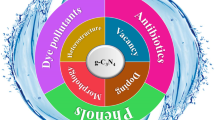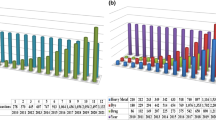Abstract
Graphitic-like carbon nitride (g-C3N4) photocatalyst was synthesized by a facile chemical pyrolysis method, which was built on the self-condensation of different precursors to generate g-C3N4, e.g., melamine, urea, and thiocarbamide. And the different precursors produced a great influence on the photocatalytic activities of g-C3N4. Heterojunctions of g-C3N4 and BiVO4 were synthesized using a facile solvent evaporation method. The formation of BiVO4/g-C3N4 composites were confirmed by XRD, FT-IR, SEM, XPS, and UV-Vis DRS. The photocatalytic activities for RhB degradation were evaluated under visible-light irradiation. The photocatalytic activity of g-C3N4 prepared by urea was higher than that of g-C3N4 prepared by melamine and thiocarbamide, which was attributed to its favorable dispersibility, larger specific surface area, and higher oxidation capacity. The heterojunction composites exhibited higher photocatalytic activity than pure g-C3N4 or BiVO4. The results showed obvious removal efficiency for RhB, and the optimal sample with a BiVO4 content of 10% exhibited higher efficiency than pure g-C3N4 and BiVO4, and 10 wt%BiVO4/CN-U showed the highest photocatalytic activity. The enhanced photocatalytic activity of BiVO4/g-C3N4 composite can be attributed to the intimate coupling between the two host substrates, resulting in an efficient charge separation.













Similar content being viewed by others
References
Bai ZG, Hu Y, Yan SQ, Shan WJ, Wei CH (2017) Preparation of mesoporous SiO2/Bi2O3/TiO2 superhydrophilic thin films and their surface self-cleaning properties. RSC Adv 7:1966–1974
Caux M, Fina F, Irvine JT, Idriss H, Howe R (2017) Impact of the annealing temperature on Pt/g-C3N4 structure, activity and selectivity between photodegradation and water splitting. Catal Today 287:182–188
Chen X, Mao S (2007) Titanium dioxide nanomaterials: synthesis, properties, modifications, and applications. Chem Rev 107:2891–2959
Chen F, Yang Q, Wang Y, Zhao J, Wang D, Li X, Zeng G (2017) Novel ternary heterojunction photcocatalyst of Ag nanoparticles and g-C3N4 nanosheets co-modified BiVO4 for wider spectrum visible-light photocatalytic degradation of refractory pollutant. Appl Catal B Environ 205:133–147
Cheng J, Yan XL, Mo QH, Liu BT, Wang J, Yang X, Li L (2017) Facile synthesis of g-C3N4/BiVO4 heterojunctions with enhanced visible light photocatalytic performance. Ceram Int 43:301–307
Dong F, Zhao ZW, Xiong T, Ni ZL, Zhang WD, Sun YJ, Ho WK (2013) In situ construction of g-C3N4/g-C3N4 metal-free heterojunction for enhanced visible-light photocatalysis. ACS Appl Mater Interfaces 5(21):11392–11401
Gao H, Zhang P, Zhao J, Zhang Y, Hu J, Shao G (2017) Plasmon enhancement on photocatalytic hydrogen production over the Z-scheme photosynthetic heterojunction system. Appl Catal B Environ 210:297–305
He Z, Shi Y, Gao C, Wen L, Chen J, Song S (2013) BiOCl/BiVO4 p–n heterojunction with enhanced photocatalytic activity under visible-light irradiation. J Phys Chem C 118(1):389–398
Jiang DL, Xiao P, Shao LQ, Li D, Chen M (2017) RGO-promoted all-solid-state g-C3N4/BiVO4 Z-scheme heterostructure with enhanced photocatalytic activity toward the degradation of antibiotics. Ind Eng Chem Res 56:8823–8832
Lan ZA, Zhang G, Wang X (2016) A facile synthesis of Br-modified g-C3N4 semiconductors for photoredox water splitting. Appl Catal B Environ 192:116–125
Li H, Bian Z, Zhu J, Zhang D, Li G, Huo Y, Lu Y (2007) Mesoporous titania spheres with tunable chamber stucture and enhanced photocatalytic activity. J Am Chem Soc 129(27):8406–8407
Li H, Liu J, Hou W, Du N, Zhang R, Tao X (2014a) Synthesis and characterization of g-C3N4/Bi2MoO6 heterojunctions with enhanced visible light photocatalytic activity. Appl Catal B Environ 160:89–97
Li CJ, Wang SP, Wang T, Wei YJ, Zhang P (2014b) Monoclinic porous BiVO4 networks decorated by discrete g-C3N4 nano-islands with tunable coverage for highly efficient photocatalysis. Small 10(14):2782–2782
Li C, Du Y, Wang D, Yin S, Tu W, Chen Z, Xu R (2017) Unique P-Co-N surface bonding states constructed on g-C3N4 nanosheets for drastically enhanced photocatalytic activity of H2 evolution. Adv Funct Mater 27:1604328
Lucchetti R, Siciliano A, Clarizia L, Russo D, Di Somma I, Di Natale F, Marotta R (2017) Sacrificial photocatalysis: removal of nitrate and hydrogen production by nano-copper-loaded P25 titania. A kinetic and ecotoxicological assessment. Environ Sci Pollut Res 24(6):5898–5907
Molinari A, Argazzi R, Maldotti A (2013) Photocatalysis with Na4W10O32 in water system: formation and reactivity of OH radicals. J Mol Catal A Chem 372:23–28
Monfort O, Sfaelou S, Satrapinskyy L, Plecenik T, Roch T, Plesch G, Lianos P (2017) Comparative study between pristine and Nb-modified BiVO4 films employed for photoelectrocatalytic production of H2 by water splitting and for photocatalytic degradation of organic pollutants under simulated solar light. Catal Today 280:51–57
Niu M, Zhu R, Tian F, Song K, Cao G, Ouyang F (2015) The effects of precursors and loading of carbon on the photocatalytic activity of C–BiVO4 for the degradation of high concentrations of phenol under visible light irradiation. Catal Today 258:585–594
Oseghe EO, Ndungu PG, Jonnalagadda SB (2015) Synthesis of mesoporous Mn/TiO2 nanocomposites and investigating the photocatalytic properties in aqueous systems. Environ Sci Pollut Res 22(1):211–222
Pei LZ, Wang S, Jiang YX, Xie YK, Li Y, Guo YH (2013) Single crystalline Sr germanate nanowires and their photocatalytic performance for the degradation of methyl blue. CrystEngComm 15(38):7815–7823
Qiu X, Li L, Zheng J, Liu J, Sun X, Li G (2008) Origin of the enhanced photocatalytic activities of semiconductors: a case study of ZnO doped with Mg2+. J Phys Chem C 112(32):12242–12248
Shan WJ, Hu Y, Bai ZG, Zheng MM, Wei CH (2016) In situ preparation of g-C3N4/bismuth-based oxide nanocomposites with enhanced photocatalytic activity. Appl Catal B Environ 188:1–12
Shang Z, Sun M, Chang S, Che X, Cao X, Wang L, Lu G (2017) Activity and stability of Co3O4-based catalysts for soot oxidation: the enhanced effect of Bi2O3 on activation and transfer of oxygen. Appl Catal B Environ 209:33–44
Shi H, Chen G, Zhang C, Zou Z (2014) Polymeric g-C3N4 coupled with NaNbO3 nanowires toward enhanced photocatalytic reduction of CO2 into renewable fuel. ACS Catal 4(10):3637–3643
Song X, Hu Y, Zheng MM, Wei CH (2016) Solvent-free in situ synthesis of g-C3N4/{001}TiO2 composite with enhanced UV-and visible-light photocatalytic activity for NO oxidation. Appl Catal B Environ 182:587–597
Song C, Fan M, Shi W, Wang W (2018) High-performance for hydrogen evolution and pollutant degradation of reduced graphene oxide/two-phase g-C3N4 heterojunction photocatalysts. Environ Sci Pollut Res 25:14486–14498
Suyana P, Priyanka G, Nair BN, Abdul APM, Krishna GKW (2017) Role of precursors on the photophysical properties of carbon nitride and its application for antibiotic degradation. Environ Sci Pollut Res Int 24(9):8609–8618
Tan G, Zhang L, Ren H, Wei S, Huang J, Xia A (2013) Effects of pH on the hierarchical structures and photocatalytic performance of BiVO4 powders prepared via the microwave hydrothermal method. ACS Appl Mater Interfaces 5(11):5186–5193
Tian G, Chen Y, Zhou W, Pan K, Dong Y, Tian C, Fu H (2011) Facile solvothermal synthesis of hierarchical flower-like BiMoO6 hollow spheres as high performance visible-light driven photocatalysts. J Mater Chem 21(3):887–892
Van Doorslaer X, Demeestere K, Heynderickx PM, Caussyn M, Van Langenhove H, Devlieghere F, Dewulf J (2013) Heterogeneous photocatalysis of moxifloxacin: identification of degradation products and determination of residual antibacterial activity. Appl Catal B Environ 138:333–341
Wang X, Maeda K, Thomas A, Takanabe K, Xin G, Carlsson JM, Antonietti M (2009) A metal-free polymeric photocatalyst for hydrogen production from water under visible light. Nat Mater 8(1):76–80
Wang Y, Sun JY, Li J, Zhao X (2017) Electrospinning preparation of nanostructured g-C3N4/BiVO4 composite films with an enhanced photoelectrochemical performance. Langmuir 33:4694–4701
Wood P, Glasser FP (2004) Preparation and properties of pigmentary grade BiVO4 precipitated from aqueous solution. Ceram Int 30(6):875–882
Wu W, Zhang SF, Ren F, Xiao XH, Zhou J, Jiang CZ (2011) Controlled synthesis of magnetic iron oxides@SnO2 quasi-hollow core–shell heterostructures: formation mechanism, and enhanced photocatalytic activity. Nano 3:4676–4684
Yan SC, Lv SB, Li ZS, Zou ZG (2010) Organic–inorganic composite photocatalyst of g-C3N4 and TaON with improved visible light photocatalytic activities. Dalton Trans 39(6):1488–1491
Zhang GG, Zhang JS, Zhang MW, Wang XC (2012) Polycondensation of thiourea into carbon nitride semiconductors as visible light photocatalysts. J Mater Chem 22:8083–8091
Zhang J, Wang Y, Jin J, Zhang J, Lin Z, Huang F, Yu J (2013) Efficient visible-light photocatalytic hydrogen evolution and enhanced photostability of core/shell CdS/g-C3N4 nanowires. ACS Appl Mater Interfaces 5(20):10317–10324
Zhang Q, Xu B, Yuan S, Zhang M, Ohno T (2017) Improving g-C3N4 photocatalytic performance by hybridizing with Bi2O2CO3 nanosheets. Catal Today 284:27–36
Funding
This work was supported by the National Natural Science Foundation of China (21577039, 21777047, 21277051), Science and Technology Planning Project of Guangdong Province, China (2015A020215004), and Scientific Research Project of Guangzhou City (201804020026).
Author information
Authors and Affiliations
Corresponding author
Additional information
Responsible editor: Suresh Pillai
Electronic supplementary material
ESM 1
(DOC 182 kb)
Rights and permissions
About this article
Cite this article
Cui, P., Hu, Y., Zheng, M. et al. Enhancement of visible-light photocatalytic activities of BiVO4 coupled with g-C3N4 prepared using different precursors. Environ Sci Pollut Res 25, 32466–32477 (2018). https://doi.org/10.1007/s11356-018-3119-3
Received:
Accepted:
Published:
Issue Date:
DOI: https://doi.org/10.1007/s11356-018-3119-3




